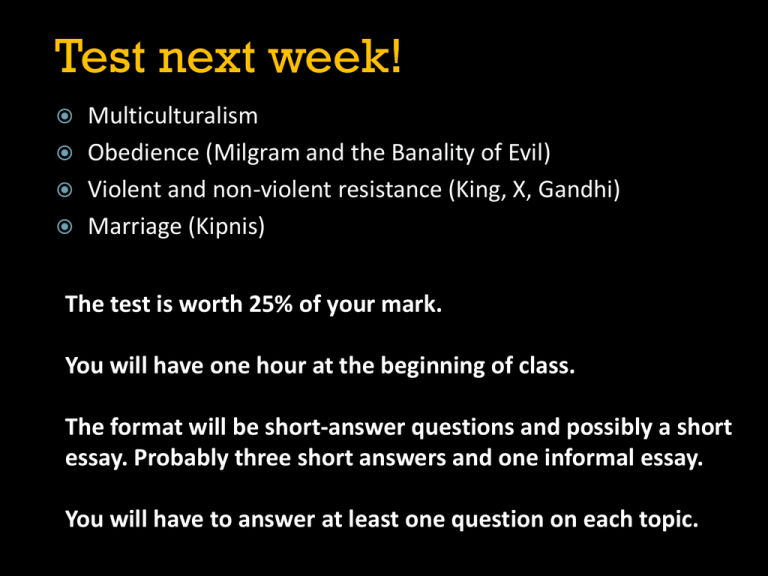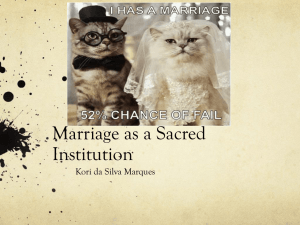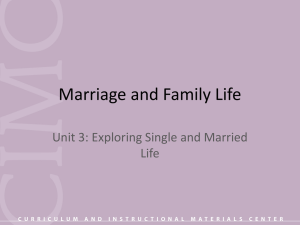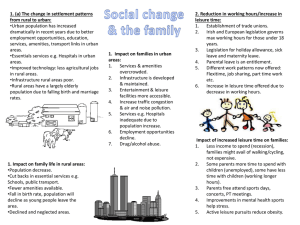
Test next week!
Multiculturalism
Obedience (Milgram and the Banality of Evil)
Violent and non-violent resistance (King, X, Gandhi)
Marriage (Kipnis)
The test is worth 25% of your mark.
You will have one hour at the beginning of class.
The format will be short-answer questions and possibly a short
essay. Probably three short answers and one informal essay.
You will have to answer at least one question on each topic.
Marriage: Then and Now
Stephanie Coontz
Professor of History and Family Studies
Marriage: Then and Now
A capsule history of Western
marriage
Marriage Before the 1800s
Before the 1600s
Mostly upper class and used to transfer
property and power
Used to establish political alliances
Keep bloodlines pure (dynasties)
1600s to 1800s (rising middle class)
Marriage becomes more common and
more important
Men rule over women and children;
women have no welfare outside of
marriage
Men are considered inadequate and can’t
get credit unless they are married
The “Traditional” Marriage
1800s – 1950s
With the Industrial Revolution in the 1800s, the roles that we now think
of as traditional became the standard:
The man goes to work (in factory, etc)
The woman stays at home (raises children, tends vegetable garden,
cooks, etc)
Meanwhile, gradually changes begin to occur that would undermine the
centrality of marriage:
Social institutions such as public education, social security, etc make the
family a less important factor in individual welfare
Two world wars and the dissemination of progressive thought bring
women into the workforce and give them more rights
Changes starting in the 1960s
Birth control
TV Dinners
Women’s Rights
The Sexual Revolution
Religious doctrine less powerful
Single parents more common
Divorce more acceptable
Same-sex couples
Emergence of common law
1970s - present
The ideal of an intimate marriage
deepened some relationships but also
made unsatisfying marriages more
difficult to sustain.
Many people now actually demand
Courtship and Romance
Sexual compatibility
Shared goals
Personal happiness
Gender roles have become less rigid
(stay-at-home dads) and coupling is
less
about reinforcing traditional
heterosexual roles.
Now
50% of marriages end in divorce
Alternatives to marriage are increasingly available and
accepted: common law, cohabitation, single parenting
People mainly “have to” get married or stay married
because of religion, their families, or “for the sake of the
children”
In two-breadwinner households women as the childbearers still often don’t get fair treatment
Half the people who get married get divorced and more
than half of those who stay married say they are unhappy
Does the institution need to be
overhauled?
“As therapist Betty Carter has commented, if
any other institution in this country [the
United States] was failing half the people
who entered it, we would demand that the
institution change to fit the people’s needs,
not the other way around.”
(Human Project, p. 111)
Or should we just get rid of it?
We’ve gotten rid of other social institutions that people
once held dear or took for granted and that in many cases
were sanctioned by religions and enforced by
governments, but that now seem wrong or inhuman:
divine right of kings; the nobility exempted from taxation
forced religious conversion
child labour
women denied the right to vote
slavery (some would say marriage has often been a form)
Marriage is Made in Hell
Laura Kipnis
Professor of Media Studies, Northwestern
University
Marriage is a form of social
control that enslaves not just
women, but men as well.
Make sure you understand
and/or think about (not just memorize) these
concepts:
Changes in Western marriage since the Middle
Ages
Laura Kipnis’s arguments against marriage as an
institution
Quiz (2 marks)
1. Explain the concept of satyagraha as defined in
the lecture on resistance.
2. What is the difference between segregation and
separation? Who was in favour of segregation
and who was in favour of separation, as
explained in the lecture on resistance?
3. Laura Kipnis gives three examples of how
marriage is hellish. What is one of them?
4. Kipnis ultimately wants to make a point that goes
beyond marriage. What is it?








